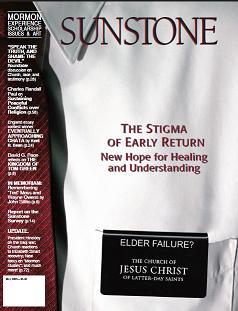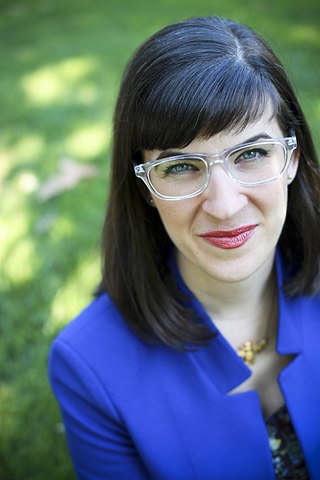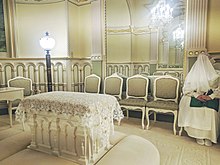
The Church of Jesus Christ of Latter-day Saints, informally known as the LDS Church or Mormon Church, is a restorationist, nontrinitarian Christian denomination that is the largest denomination in the Latter Day Saint movement. The church is headquartered in the United States in Salt Lake City, Utah and has established congregations and built temples worldwide. According to the church, it has over 17 million members and over 99,000 volunteer missionaries. The church was the fourth-largest Christian denomination in the United States as of 2012, and reported over 6.8 million US members as of 2023.

Sonia Ann Johnson, is an American feminist activist and writer. She was an outspoken supporter of the Equal Rights Amendment (ERA) and in the late 1970s was publicly critical of the position of the Church of Jesus Christ of Latter-day Saints, of which she was a member, against the proposed amendment. She was eventually excommunicated from the church for her activities. She went on to publish several radical feminist books, ran for president in 1984, and become a popular feminist speaker.
The September Six were six members of the Church of Jesus Christ of Latter-day Saints who were excommunicated or disfellowshipped by the church in September 1993, allegedly for publishing scholarly work against or criticizing church doctrine or leadership. The term "September Six" was coined by The Salt Lake Tribune and was used in the media and subsequent discussion. The church's action was referred to by some as evidence of an anti-intellectual posture on the part of church leadership.
The status of women in Mormonism has been a source of public debate since before the death of Joseph Smith in 1844. Various denominations within the Latter Day Saint movement have taken different paths on the subject of women and their role in the church and in society. Views range from the full equal status and ordination of women to the priesthood, as practiced by the Community of Christ, to a patriarchal system practiced by the Church of Jesus Christ of Latter-day Saints, to the ultra-patriarchal plural marriage system practiced by the Fundamentalist Church of Jesus Christ of Latter-Day Saints and other Mormon fundamentalist groups.
Dennis Michael Quinn was an American historian who focused on the history of The Church of Jesus Christ of Latter-day Saints. He was a professor at Brigham Young University (BYU) from 1976 until he resigned in 1988. At the time, his work concerned church involvement with plural marriage after the 1890 Manifesto, when new polygamous marriages were officially prohibited. He was excommunicated from the church as one of the September Six and afterwards was openly gay. Quinn nevertheless identified as a Latter-day Saint and continued to believe in many LDS teachings, though he did not actively practice the faith.
Ex-Mormon or post-Mormon refers to a disaffiliate of the Church of Jesus Christ of Latter-day Saints or any of its schismatic breakoffs, collectively called "Mormonism". Ex-Mormons—sometimes referred to as exmo or postmo—may neither believe in nor affiliate with the LDS Church. In contrast, Jack Mormons may believe but do not affiliate; and cultural Mormons may or may not affiliate but do not believe in certain doctrines or practices of the LDS Church. The distinction is important to a large segment of ex-Mormons, many of whom consider their decision to leave as morally compelling and socially risky. According to 2014 Pew data, around 1/3 of adults raised LDS no longer adhere to the faith and in 2008 only 25% of LDS young adults were actively involved. Many ex-Mormons experience troubles with family members who still follow Mormon teachings. Aggregations of ex-Mormons may comprise a social movement.
Lavina Fielding Anderson was a Latter-day Saint scholar, writer, editor, and feminist. Anderson held a PhD in English from the University of Washington.
The Mormon Alliance was founded on July 4, 1992 by Paul Toscano to counter perceived spiritual and ecclesiastical abuse in the Church of Jesus Christ of Latter-day Saints and to protect the Church against defamatory actions. During the next few months, the trustees established a broad range of supporting purposes: providing a comprehensive definition of spiritual abuse, working to reconcile leaders and members who were out of harmony, establishing a Members’ Bill of Rights, providing a forum for a reasonable and tempered discussion of governance in the Church, critiquing general conference, and identifying and documenting cases of spiritual and ecclesiastical abuse. Janice Merrill Allred and Lavina Fielding Anderson, two of the trustees, became co-chairs of the Case Reports Committee in the fall of 1992 and still serve in those positions. Toscano and Fielding Anderson were excommunicated by the Church following their actions.

Sunstone is a magazine published by the Sunstone Education Foundation, Inc., a 501(c)(3) nonprofit corporation, that discusses Mormonism through scholarship, art, short fiction, and poetry. The foundation began the publication in 1974. The magazine's motto is Faith Seeking Understanding.
Exponent II is a quarterly periodical, the longest-running independent publication for Latter-day Saint women. At its launch, by a women's group in Massachusetts in 1974, it described itself as a "spiritual descendent" of the Woman's Exponent, founded 100 years earlier. A print edition remains available, while the journal has also been published online since 2007. The Exponent II organization also runs a program of annual residential retreats since the 1980s, and supports a blog, The Exponent.
Feminist Mormon Housewives (fMh) is a group blog, podcast, and Facebook group featuring commentary and discussion on contemporary Mormon culture and women's issues. According to The New York Times, "Unlike the more mainstream Mormon blogs – known collectively as the Bloggernacle – that by and large promote the faith, this online diary focuses on the universal challenges of mothering young children and on frustration with the limited roles women have in the Church of Jesus Christ of Latter-day Saints."

Neylan McBaine is an American writer and marketer. As a writer, she focuses on topics related to women in Mormonism. She has been published in Patheos.com, PowerofMoms.com, Newsweek,Dialogue: A Journal of Mormon Thought,Segullah,Meridian Magazine and BustedHalo.com.
Mormon studies is the interdisciplinary academic study of the beliefs, practices, history and culture of individuals and denominations belonging to the Latter Day Saint movement, a religious movement associated with the Book of Mormon, though not all churches and members of the Latter Day Saint movement identify with the terms Mormon or Mormonism. Denominations of the Latter Day Saint movement include the Church of Jesus Christ of Latter-day Saints, by far the largest, as well as the Community of Christ (CoC) and other smaller groups, include some categorized under the umbrella term Mormon fundamentalism.
Peggy Fletcher Stack is an American journalist, editor, and author. Stack has been the lead religion writer for The Salt Lake Tribune since 1991. She and five other journalists at the Salt Lake Tribune won the 2017 Pulitzer Prize for Local Reporting. She won the Cornell Award for Excellence in Religion Reporting—Mid-sized Newspapers from the Religious News Association in 2004, 2012, 2017, 2018, and 2022.

Latter-day Dissent: At the Crossroads of Intellectual Inquiry and Ecclesiastical Authority is a 2011 book edited, with an introduction, by Philip Lindholm. It chronicles the stories of prominent LDS intellectuals who faced disciplinary action by the LDS Church. The book features contributions from members of the September Six, including Lynne Kanavel Whitesides, Paul Toscano, Maxine Hanks, Lavina Fielding Anderson, D. Michael Quinn, as well as Janice Merrill Allred, Margaret Merrill Toscano, Thomas W. Murphy, and Donald Jessee. Lindholm's analysis combined with Diarmaid MacCulloch's foreword and the interviews themselves collectively discuss the nature and extent of intellectual freedom and disciplinary action in the LDS Church.
Ordain Women is a Mormon feminist organization that supports the ordination of women to the priesthood in the Church of Jesus Christ of Latter-day Saints. It was founded on March 17, 2013, by Kate Kelly, a human rights attorney from Washington, D.C., with the website launch containing 19 profiles of individuals calling for the ordination of Mormon women. As of May 17, 2014, the website featured more than 400 profiles.

Kathleen Marie Kelly is an American activist, human rights lawyer, and Mormon feminist who founded Ordain Women, an organization advocating for the ordination of women to the priesthood in the Church of Jesus Christ of Latter-day Saints. Kelly was excommunicated from the church in 2014. She is also a nationally known advocate for ratification of the Equal Rights Amendment (ERA) and abortion access.
Fiona Givens is an American writer, teacher, and speaker who focuses on matters of history, theology, and culture of the Church of Jesus Christ of Latter-day Saints.
Lindsay Hansen Park is an American Mormon feminist blogger, podcaster, and the executive director for the Salt Lake City-based non-profit Sunstone Education Foundation.
This is a bibliography of literature treating the topic of criticism of Mormonism, sorted by alphabetical order of titles.







